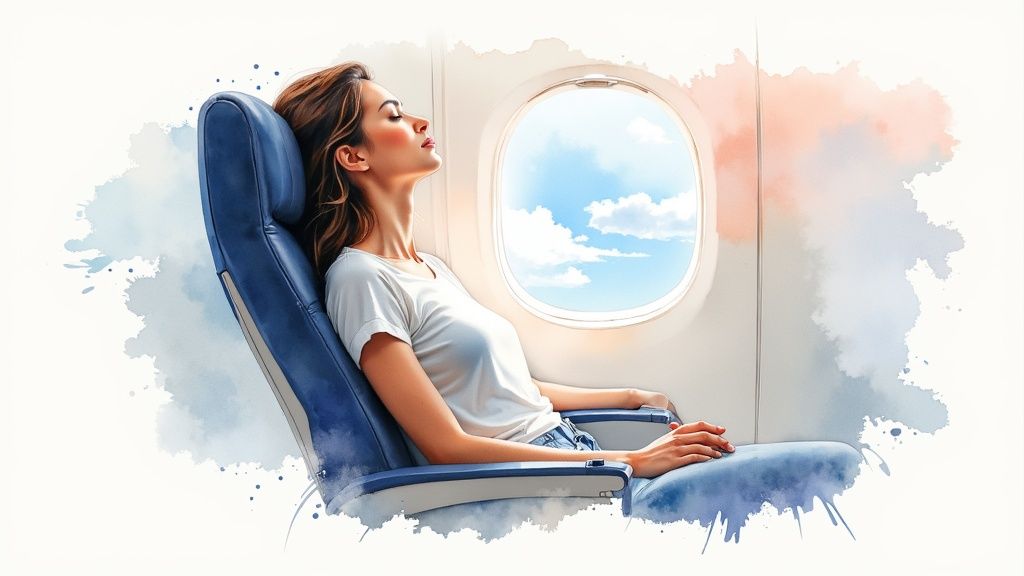
Dealing with turbulence anxiety starts with a simple, yet powerful truth: You can heal from this fear and fly without panic. The journey begins when you stop seeing those jarring bumps as a sign of danger and start seeing them for what they are—a normal, safe part of air travel, much like a car driving over a bumpy road.
Finding Hope in a Shaky Cabin
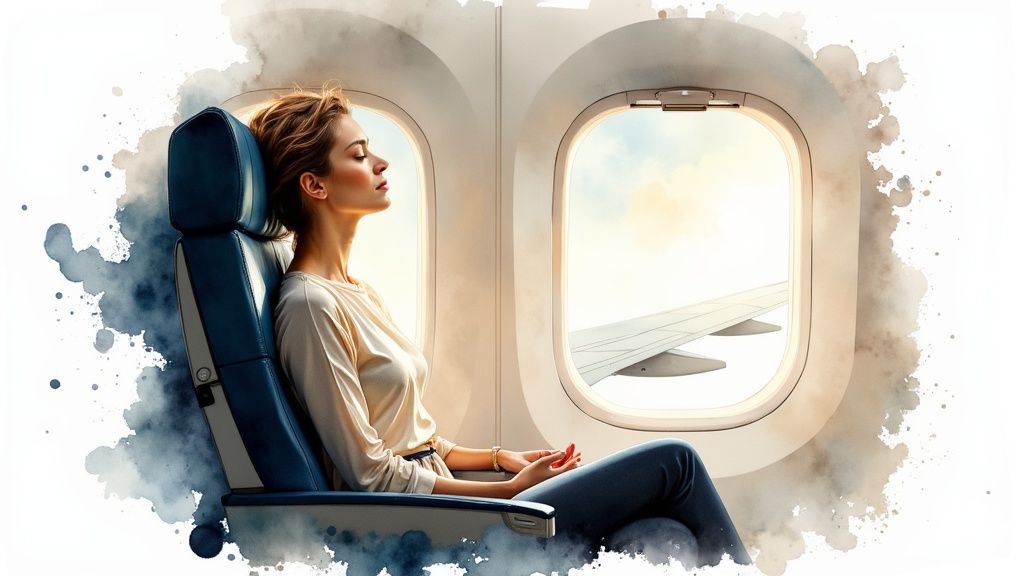
That sudden shudder of the plane is a familiar trigger for so many of us. It's that heart-in-your-throat moment where your mind starts racing, and it can feel incredibly isolating. But you are far from alone, and a life free from this panic is entirely possible.
In fact, research shows that somewhere between 33% to 40% of people feel some level of anxiety about flying. That ranges from a little pre-flight unease to a full-blown phobia that can get in the way of life's adventures.
The journey to overcoming this fear doesn’t start at 30,000 feet. It starts right here, with the understanding that you have the power to heal your relationship with flying.
This guide is about hope and empowerment. Healing from flight anxiety isn't about wishing turbulence away; it's about changing your response to it. It’s about building a toolkit of mental and physical strategies that put you back in control of your emotions, so you can travel with confidence and look forward to your adventures.
Shifting Your Mindset Before Takeoff
Your path to a calmer flight begins by challenging the automatic thoughts that fuel your fear. The goal is to catch that anxiety spiral before it picks up speed, replacing catastrophic thinking with rational, reassuring truths. This mental shift is the foundation for a panic-free future.
Before diving into specific exercises, it helps to start with a few quick mindset shifts. Think of these as your pre-flight mental prep for a successful, peaceful journey.
| Quick Mindset Shifts for Anxious Flyers | |
|---|---|
| Anxious Thought | Empowering Reframe |
| "This shaking means we're in danger." | "This is just like driving on a bumpy road. Uncomfortable, but not unsafe." |
| "I'm losing control and I can't handle this." | "My fear is a feeling, not a fact. I have tools to manage this moment and I will be okay." |
| "What if the plane falls?" | "Planes are built for this. The pilots are trained for this. I am safe." |
| "I have to get off this plane right now." | "This feeling will pass. I'm focusing on where I'm going and why this journey is worth it." |
Internalizing these reframes takes practice, but it's the first step toward retraining your brain to recognize safety and reclaim your peace, even when the cabin shakes.
Here are a few ways to begin that process:
- Acknowledge Your Feelings Without Judgment: Your fear is just your nervous system trying to protect you. Instead of fighting it, just notice it. A simple "I'm feeling scared, and that's okay, I am safe" can be incredibly powerful.
- Embrace the Analogy: Keep reminding yourself that turbulence is to a plane what bumps are to a car. It feels weird, but it's not dangerous. Repeat it like a mantra if you have to.
- Focus on the Destination: Shift your mental energy away from the flight and onto the exciting experiences waiting for you. Visualize yourself arriving, feeling happy, proud, and free.
This journey is about reclaiming your freedom. Every small step you take to manage your anxiety is a victory, proving to yourself that you are stronger than your fear and that a panic-free life is possible.
This initial reframing is crucial. Mastering simple yet powerful breathing exercises for anxiety can also give you immediate relief when you feel panic setting in. By starting with these foundational mindset shifts, you’re laying the groundwork for a much more peaceful travel experience.
What Turbulence Actually Is (And Why It’s Totally Safe)
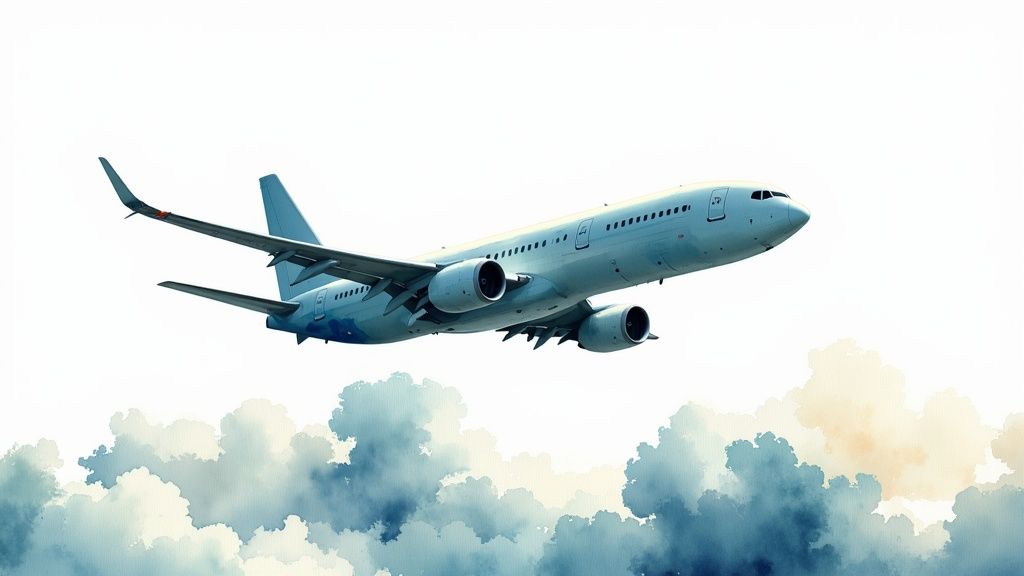
One of the most powerful tools for calming turbulence anxiety is simply understanding what’s really happening up there at 30,000 feet. The fear of the unknown is almost always worse than the reality. When your mind fills in the gaps with worst-case scenarios, it kicks your body into high alert. You can learn exactly how this happens in our guide to the fight-or-flight response.
So let's disarm that fear by replacing anxious thoughts with cold, hard facts. Turbulence is just unstable air. It's not a sign the plane is failing; it's a perfectly normal atmospheric condition that pilots and planes are built to handle every single day.
Think of an airplane like a boat on the ocean. You’d never expect the water to be perfectly smooth for an entire trip, right? There will be small waves, and sometimes, bigger, choppier ones. Turbulence is just the aerial version of those waves. While it might feel dramatic, the plane is simply navigating different currents of air.
Common Causes of Bumpy Air
The air in our atmosphere is always moving, and a few different things can create these "air waves." When you know what causes them, turbulence shifts from being a vague, scary threat into a predictable, natural event.
- Weather Fronts: This is when warm and cold air masses meet. The boundary between them can create unstable air, just like the wind picks up on the ground before a storm rolls in.
- Jet Streams: These are high-speed "rivers" of air that circle the globe. Flying into, out of, or even across a jet stream can cause some bumps as the plane transitions between air moving at different speeds.
- Mountainous Terrain: Air flowing over mountains gets all jumbled up, creating waves that can stretch for miles. Pilots know exactly where these spots are and plan their routes accordingly.
- Clear-Air Turbulence (CAT): This is the kind that seems to pop up out of nowhere on a beautiful, clear day. It’s usually caused by shifts in the jet stream. While it can be surprising, it's completely normal.
The key takeaway is this: Modern commercial aircraft are engineered to withstand forces far greater than any turbulence they will ever encounter. What feels like a dramatic drop to you is often a change in altitude of just a few feet.
Built for Strength and Piloted by Experts
Commercial airplanes are incredible machines. Their wings aren't rigid; they’re designed to be flexible, allowing them to absorb the stress of turbulence by bending and flexing. This is a crucial safety feature, not a sign of weakness. Every single aircraft goes through punishing stress tests that simulate conditions way more extreme than anything found in nature.
On top of that, pilots are highly trained professionals who see turbulence as just another part of the job—not an emergency. They use sophisticated weather radar to see turbulent areas ahead of time and will often fly around them when possible. Their calm voice over the intercom isn't just for show; it reflects a deep understanding that the situation is completely under control.
It’s a testament to aviation safety that even though severe turbulence incidents have increased by 55% over the North Atlantic since 1979 due to climate change, flying remains incredibly safe. Your number one safety tool is your seatbelt. Keeping it fastened whenever you're seated is the single best thing you can do to stay secure and ease your mind.
In-Flight Techniques to Ground Your Anxiety
When your heart starts pounding at 30,000 feet, you need a toolkit you can actually use right there in your seat. Knowing what to do in the moment is incredibly empowering. It shifts the dynamic from feeling helpless and trapped to feeling prepared and in control—a huge step in learning how to deal with turbulence anxiety for good.
The goal here isn't to fight the anxiety. It's about gently guiding your body and mind back to a state of calm. These aren’t just distractions; they are active techniques designed to interrupt the panic cycle before it spirals. By focusing on your breath, your body, and your immediate surroundings, you can send a powerful signal to your nervous system that you are, in fact, safe.
Master Your Breath to Master Your Nerves
When we panic, our breathing becomes shallow and rapid, which only pours fuel on the anxiety fire. The single most effective thing you can do in your seat is to consciously take back control of your breath. One of the best methods for this is the 4-7-8 breathing technique.
It’s so simple, yet it works wonders. Inhale quietly through your nose for a count of four. Hold your breath for a count of seven. Then, exhale completely through your mouth for a count of eight. Repeating this cycle just three or four times can physically slow your heart rate and flip the switch on your body's relaxation response.
Reconnect with Your Body Through Grounding
Turbulence can create a dizzying, disorienting feeling of being out of control, making you feel totally disconnected from your own body. This is where physical grounding techniques come in. These simple actions pull your awareness out of a catastrophic thought spiral and anchor you firmly in the present moment.
- Press Your Feet Firmly: Plant both of your feet flat on the floor of the plane. Really concentrate on the sensation—the texture of the carpet under your shoes, the solid pressure. This simple act creates a powerful physical anchor to the aircraft.
- Engage Your Senses: Focus intently on the texture of the armrest under your fingertips. Is it smooth, cool plastic or a woven fabric? Notice its temperature. Giving your brain a specific, non-threatening sensory task pulls it away from "what-if" thinking.
- Clench and Release: Make tight fists with your hands, squeezing for five seconds, and then let go. Pay close attention to the wave of relaxation that washes over your hands as you release. You can do the same with your toes inside your shoes.
For a deeper dive into these methods, you can explore more powerful grounding techniques for anxiety that are easy to adapt for air travel.
This infographic breaks down a simple three-step process you can follow the moment you feel that first flicker of anxiety.
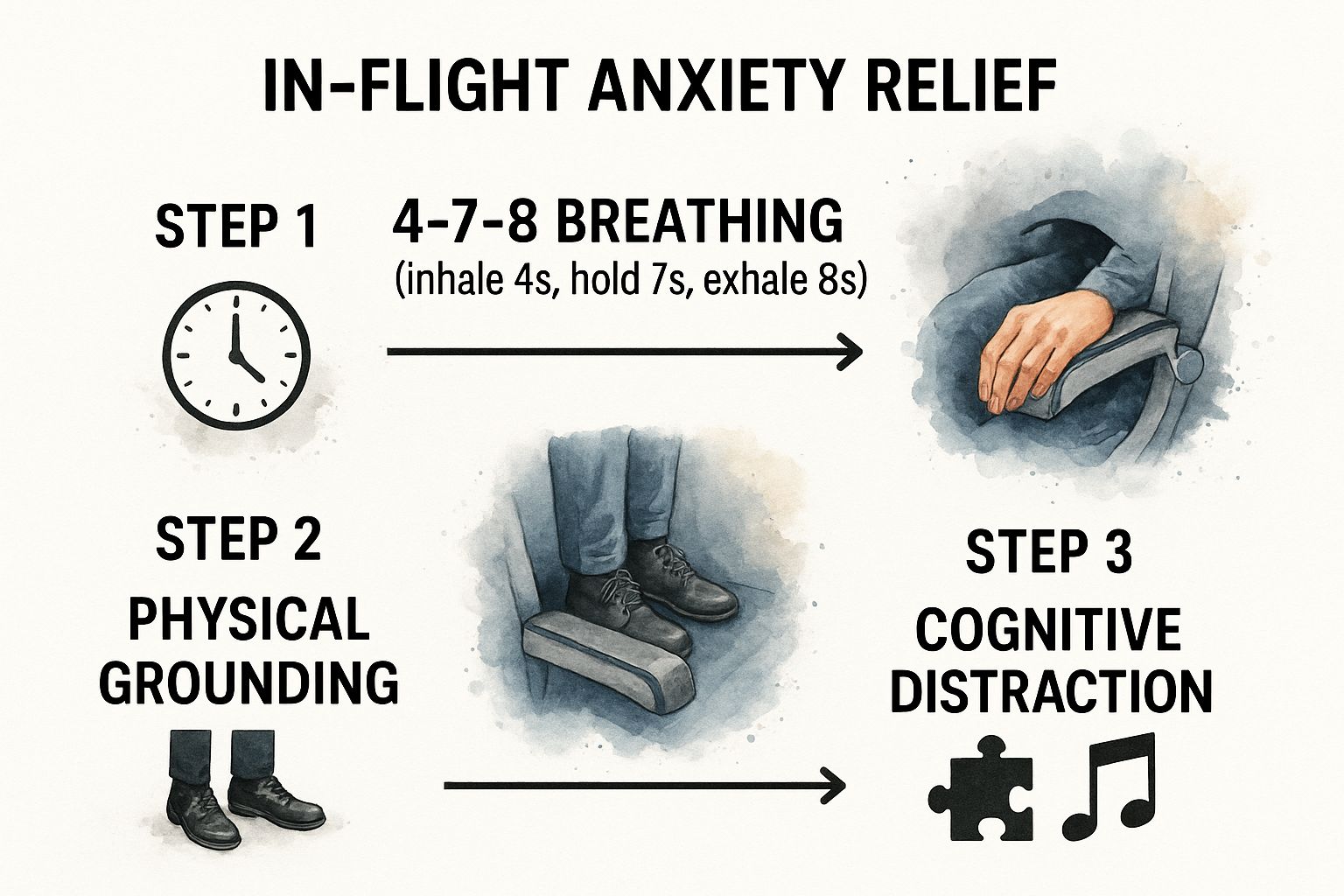
The sequence shown here—breathing, grounding, and distracting—gives you a clear and effective pathway to regain control when you feel like you're losing it.
Distract Your Brain with Intention
While just trying to "think about something else" can help a little, intentional cognitive engagement is far more powerful. You need to give your brain a job to do—one that requires enough focus to genuinely pull it away from the anxious thoughts.
The key is to choose an activity that is absorbing but not stressful. Your goal is to redirect your mental energy, not create more tension.
Some of my go-to methods include:
- Engage in a Puzzle: A challenging sudoku, crossword, or logic puzzle on your tablet can completely absorb your analytical mind, leaving little room for worry.
- Write with Your Non-Dominant Hand: Try writing your name or a simple sentence with the opposite hand you normally use. This task is surprisingly difficult and requires intense concentration, which is perfect for breaking out of automatic thought patterns.
- Create a Themed Playlist: Don't just hit shuffle. Before your flight, create a playlist with songs that make you feel happy, calm, or confident. When turbulence hits, focus intently on the lyrics or the instruments.
How Preparation Can Reduce Your In-Flight Fear
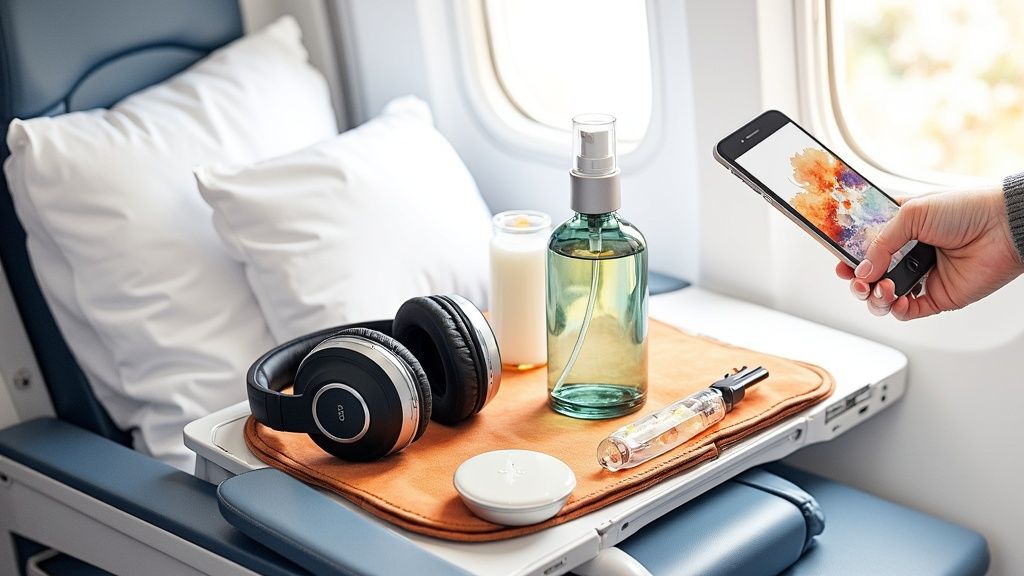
One of the most powerful ways to get a handle on turbulence anxiety is to start long before you even head to the airport. Think of it this way: instead of letting dread build, you can turn that time into an opportunity to feel empowered. When you’re prepared, you build a foundation of calm that you can carry right onto the plane with you.
This whole process starts with arming yourself with knowledge. Rather than avoiding every detail about your flight, you can use that information to your advantage. Modern apps with turbulence forecasts can give you a heads-up about potential bumps. The goal isn't to create more fear, but to take away the element of surprise, which is often what sends anxiety spiraling.
Live flight data is also becoming a game-changer for nervous flyers. Knowing what’s happening in real-time, coupled with a little education on atmospheric conditions, can make a huge difference. For instance, some travel apps now offer features that show live updates on the plane's position and even cabin comfort data. This is a big deal for anxious travelers, and you can learn more about how real-time flight data helps passengers feel more in the loop.
Choose Your Seat and Communicate Your Needs
A few strategic choices can genuinely change how your flight feels. Where you sit, for example, can impact how much turbulence you physically experience.
- Seats Over the Wings: This spot is the plane’s center of gravity and is usually the most stable part of the aircraft. Think of it like the middle of a seesaw—it moves a lot less than the ends.
- Seats Near the Front: The front of the plane also tends to offer a smoother ride than the very back.
Speaking up about your anxiety is another way to take back some control. Flight attendants are trained to help nervous passengers. They’re your allies up there.
Having a quiet word with a crew member as you board can make a world of difference. A simple, "Hi, I get a bit anxious during flights, and turbulence makes me nervous," lets them know to check in on you and offer some reassurance if things get bumpy.
Assemble Your In-Flight Comfort Kit
Packing a dedicated "comfort kit" in your carry-on is a tangible, practical way to prepare for any anxiety that might pop up. Having these tools right at your fingertips gives you immediate ways to soothe your nervous system.
Your kit should be personal to you, but here are a few items that I’ve found work wonders:
- Noise-Canceling Headphones: These are essential for blocking out engine noise and creating your own little bubble of calm.
- A Weighted Lap Pad or Heavy Blanket: The gentle pressure can have an incredibly grounding effect on an overstimulated nervous system.
- Calming Scents: A small rollerball of lavender or peppermint oil applied to your wrists can be surprisingly effective.
- Engaging Distractions: Pack a puzzle book, a novel you can’t put down, or download a favorite comfort movie ahead of time.
By taking these steps, you’re not just crossing your fingers for a smooth flight—you're actively creating one. This mental shift from being a passive passenger to a prepared traveler is a huge step toward flying with more confidence.
Building Long-Term Freedom from Flight Anxiety
The techniques we've covered are fantastic for getting you through a bumpy flight. But the real goal isn't just to survive anymore—it's to heal, reclaim your freedom, and travel without that shadow of fear hanging over you.
Lasting relief comes from retraining your brain’s knee-jerk reaction to flight triggers. It’s about building a deep, fundamental resilience so that anxious thoughts no longer have the final say. A life free from flight panic is possible, and the work starts long before you get to the airport.
Rewiring Your Brain with CBT
Cognitive Behavioral Therapy (CBT) is one of the most effective tools for anxiety, and it's perfectly suited for tackling a fear of flying. The idea is simple: your thoughts, feelings, and behaviors are all connected. Change your thought patterns, and you can change how you feel and react.
You can start practicing a core CBT technique called cognitive restructuring right now. It boils down to three key steps you can use the next time turbulence hits:
-
Catch the Thought: The moment the plane jolts, what's the first thing that pops into your head? Is it, "We're going to crash," or "This isn't normal"? Just notice it. No judgment, just awareness.
-
Challenge the Thought: Now, put that thought on trial. Is it based on raw emotion or actual facts? Ask yourself, "What's the evidence that this is actually dangerous?" Remind yourself what you know to be true: turbulence is a normal part of flying, planes are engineered to handle it, and pilots are experts at navigating it.
-
Change the Thought: Swap out the catastrophic thought for one that's more balanced and realistic. Instead of "This is dangerous," consciously pivot to, "This feels uncomfortable, but it's not unsafe. It’s like a car on a bumpy road, and it will pass."
This isn't about pretending you're not scared. It's about actively engaging with the fear and disarming it with logic. With practice, this new, rational response becomes more automatic than the old, fearful one, paving the way for lasting peace.
The Power of Mindfulness and Professional Guidance
Mindfulness and meditation are powerful allies on this journey. Practicing regularly trains your brain to stay in the present moment, simply observing sensations (like the bumps of turbulence) without immediately attaching a story of danger to them. You create a tiny bit of space between a trigger and your reaction, and in that space, you find the power to choose a calmer response.
Sometimes, the bravest thing you can do is admit you don't have to go it alone. If your anxiety feels like too much to handle, seeking professional support is a sign of strength and a clear path toward healing.
-
Therapy: A therapist who specializes in phobias can give you structured, proven methods like CBT to work through your fears.
-
Exposure Therapy: This approach involves gradually and safely exposing yourself to your fear in a controlled way. You can learn more about how exposure therapy for anxiety works and see why it’s so effective for so many people.
-
Fear-of-Flying Courses: Often led by a team of pilots and therapists, these programs combine education on aviation safety with psychological techniques, offering a complete roadmap to overcoming your fear.
Taking these steps is an investment in your future—a future where you can book a trip, pack your bags, and get on a plane with a sense of excitement instead of dread. A life without travel limitations is absolutely within your reach.
Common Questions About Turbulence Anxiety
Even with a solid game plan, it's natural for questions to pop up, especially when you’re 30,000 feet in the air and the plane starts to bounce.
Getting straight, factual answers to these nagging worries is one of the best ways to dismantle your fear from the inside out. It's about replacing the frantic "what ifs" with a grounded sense of "what is."
This isn’t about pretending you’re not scared. It's about arming yourself with knowledge that proves your feelings, while totally valid, don’t always match up with reality.
Can Turbulence Cause a Plane Crash?
This is the big one, isn’t it? The question at the heart of the fear. The answer is a clear and resounding no.
In the entire history of modern commercial aviation, turbulence has never been the direct cause of a plane crash. Not once.
Planes are incredible feats of engineering, built to withstand forces far more intense than any weather they'll ever fly through. That feeling of a dramatic, thousand-foot drop? It’s almost always a shift of less than 20 feet.
Pilots see turbulence as a completely normal, predictable part of their job—more like driving on a bumpy road than navigating a crisis.
The bottom line is simple: While turbulence is uncomfortable, it is not a threat to the plane's structural integrity. The aircraft is designed to handle it with ease.
What Seat Is Best to Feel Less Turbulence?
If you want to feel the bumps as little as possible, your best bet is a seat over the wings.
Think of the plane like a seesaw. The area over the wings is the center of gravity and balance, so it experiences the least amount of up-and-down motion.
On the flip side, the back of the plane, especially near the tail, tends to feel the most movement. Booking a seat over the wing can make a real difference in how smooth the ride feels, giving your nervous system fewer jolts to react to.
Does Informing the Flight Crew Help?
Absolutely. It can make a world of difference.
When you board, just have a quiet word with one of the flight attendants and let them know you're a nervous flyer. They are trained to help anxious passengers and can be a fantastic source of comfort.
They can check in on you, offer a bit of reassurance when things get bumpy, and explain any normal sounds or movements that might otherwise set off your anxiety. Think of them as your allies in the sky.
If your fear feels more deeply rooted, exploring resources on aerophobia and the fear of flying can give you more context and strategies to work with.
At The Anxiety Checklist, we believe in providing practical, actionable tools to help you live a life without limitations. Our Fearless Living system is designed to give you a personalized toolkit to manage anxiety, challenge negative thoughts, and regain control. Start your journey toward calmer travels and a more peaceful life today. Learn more and get your checklist.

